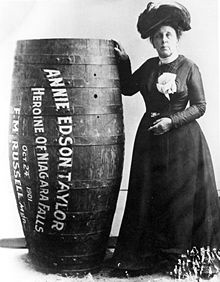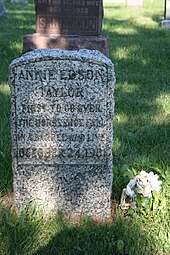Annie Taylor
Anna "Annie" Edson Taylor (* 24. October 1838 in Auburn , New York ; † 29. April 1921 in Lockport , New York) was an US -American teacher . She became known in 1901 as the first person to survive Niagara Falls in a barrel .
Life
Annie Edson grew up as one of eight children of a mill owner in Auburn, New York. After high school , she began a four year teacher training course. While studying, she married David Taylor. David Taylor was killed in the American Civil War as early as 1864 . The 25-year-old widow then moved to live with friends in Texas and took a job as a teacher there. After a short time she returned to New York and tried herself as a dance teacher .
In the years that followed, Annie Taylor led a troubled life, traveling across the United States and constantly taking on new positions as a teacher or dance instructor. She could only secure her demanding lifestyle through an inheritance and the support of relatives. In the late 1890s, Taylor finally moved to Bay City on Lake Huron . Since she could not find a job there, she opened her own dance school. When her company failed to generate the profit she had hoped for, she moved to Texas again, but returned to Bay City just a few months later. Since her financial resources were slowly being exhausted, she looked for a new income opportunity. A newspaper report on the World Exposition in Buffalo (the Pan-American Exposition ) and the popularity of the nearby Niagara Falls with visitors gave Taylor in July 1901 sudden inspiration, "Go over Niagara Falls in a barrel - no one has yet managed this feat."
Driving over Niagara Falls
Since then, the Frenchman Charles Blondin in 1859 became the first person the Niagara Falls on a high wire had crossed, the falls were a popular destination for Sensation artists. The first attempt to swim the falls failed in 1883 when the famous long-distance swimmer Matthew Webb drowned in the whirlpools of the Niagara River . An oak barrel was first used three years later when the Englishman Carlisle Graham passed the rapids of the Whirlpool Rapids below the falls. He repeated the stunt several times, most recently in July 1901, but did not dare to drive through the falls in the barrel.
Based on Graham's experience, Annie Taylor had a barrel made from selected oaks in Bay City. The barrel was around 1.40 meters long and 0.9 meters wide (4.5 × 3 feet ). It was padded with cushion and to support the passenger with a leather harness provided. Taylor contacted promoter Frank M. Russell, who signed her after some concerns and announced her plan in the press in late September. The barrel, named Queen of the Mist , was tested on October 18, 1901 in a test run with a cat as a passenger. It remained unclear whether the cat survived this trip.
On October 24, 1901, her 63rd birthday, Annie Taylor finally got into the barrel herself. Taylor was brought by a small boat to an island about a mile above the falls. After she had settled in the barrel, fresh air was forced into the barrel with the help of a bicycle pump. The barrel was sealed with a cork. To keep it vertical during the trip, the underside was weighted with an anvil.
At 4:05 p.m. the barrel was removed from the boat. It was immediately swept away by the current. After 18 minutes, the barrel reached Horseshoe Falls on the Canadian side, where it then fell 53 meters. After a minute the barrel appeared intact below the waterfall. It was pushed further downstream through the rapids until it was recovered at 4:40 pm.
To the surprise of the eyewitnesses, Annie Taylor was able to leave the barrel on her own. She said she passed out while passing the Horseshoe Falls , but was conscious again when the keg was opened. Outwardly, Annie Taylor was only injured on the back of the head, but had to be treated at the Niagara Falls hospital because of a severe shock . Immediately after the successful stunt, Taylor gave the first interviews. She thanked God for surviving this journey and warned anyone not to repeat the venture.
Post fame
The successful stunt made Annie Taylor famous overnight, but the fame faded just as quickly. While the local Niagara Falls press celebrated Taylor as a heroine, the New York newspapers were far more distant. On November 2nd, Taylor made her first big appearance after her ride at the Pan-American Exhibition in Buffalo, where she was admired by thousands of curious people. Taylor received a fee of $ 200 for this performance , a sum that was not even enough to cover her costs for performing the stunt. An appearance in Huber's Museum , a cabinet of curiosities in New York City, turned down Taylor despite the offered fee of 500 dollars, because this appearance was below her dignity. Taylor also refused to appear in the fledgling medium of film, whereupon Carlisle Graham reenacted her act in front of the film cameras.
Since Annie Taylor's real age was now known - she had initially pretended to be 43 - her manager Frank M. Russell found it increasingly difficult to find engagements for the matronly widow. In the winter of 1901/02, Taylor toured several cities in the eastern United States, where she was displayed in shop windows along with her barrel and cat. Eventually Taylor stranded bankrupt in Cleveland , Ohio . Russell then sat down with the barrel and tried his luck without Annie Taylor. Taylor found herself deprived of her last source of income and tried to find the barrel. She finally discovered it in the summer of 1902 in a Chicago theater that was staging a play called Over the Falls without her knowledge . After getting some money back from selling her autobiography, she was able to claim her keg back.
But her new manager also disappeared after a short time with the barrel. Taylor then had a replica of the barrel made with which she posed for the tourists in the town of Niagara Falls. Since selling souvenirs remained her only source of income, Annie Taylor considered repeating her journey in 1906, but did not put it into practice because of her advanced age.
On July 25, 1911, the Englishman Bobby Leach succeeded in repeating Annie Taylor's feat. Despite serious injuries, he survived the descent of Horseshoe Falls in a metal barrel. As a 52-year-old daredevil, Leach was a much more attractive hero for the media who, unlike Taylor, also achieved fame in Europe.
In the last ten years of her life, Annie Taylor tried herself as a clairvoyant despite her deteriorating health and offered the tourists at Niagara Falls treatments with the novel electrotherapy . In early 1921, Taylor had to go into the care of the Lockport poorhouse . There the press once again became aware of the forgotten Annie Taylor, and she got the opportunity to tell her life story to local reporters. Taylor died on April 29, 1921. She was buried in the Niagara Falls cemetery alongside other sensationalists.
literature
- Charles Carlin Parish: Queen of the Mist: The Story of Annie Edson Taylor, First Person Ever to Go over Niagara Falls and Survive . Heart of the Lakes Publishing, Interlaken, New York 1987, ISBN 0-932334-89-X .
- Pierre Berton: Niagara: A History of the Falls . Kodansha America, New York 1997, ISBN 1-56836-154-8 , pp. 190-206.
- Joan Murray: Queen of the Mist: The Forgotten Heroine of Niagara . Beacon Press, Boston 1999, ISBN 0-8070-6857-8 .
- Women of Bay County , Joan Totten Musinski Rezmer, Editor, Bay County Historical Society: Bay City, Michigan, 1980.
Web links
- Bay Journal: Biography of Annie Taylor
- American Heritage: Article marking the 105th anniversary of Annie Taylor's ride
Individual evidence
- ↑ “Go over Niagara Falls in a barrel. No one had ever accomplished this feat. ”; quoted from Dwight Whalen: The Lady Who Conquered Niagara: The Annie Edson Taylor Story . EGA Books, Brewer 1990.
- ↑ Sherman Zavitz: Gymnast turned stuntman thrilled thousands at Niagara . In: Niagara Falls Review, March 9, 2002.
- ↑ Shot the Whirlpool Rapids , The New York Times , July 15, 1901 (accessed July 30, 2008).
- ^ Parish: Queen of the Mist , p. 47.
- ^ Pierre Berton: Niagara , p. 198.
- ↑ E. Schrödinger , The present situation in quantum mechanics, natural scientists. 23: pp. 807-812; 823-823, 844-849. (1935). English translation: John D. Trimmer, Proceedings of the American Philosophical Society 124, pp. 323-38 (1980), reprinted in Quantum Theory and Measurement, p. 152 (1983).
- ↑ a b c d Woman goes over Niagara in a barrel , The New York Times , October 25, 1901 (accessed July 30, 2008).
- ↑ quoted from Pierre Berton: Niagara , p. 202.
- ^ Buffalo Evening News, Nov. 2, 1901.
- ↑ a b Pierre Berton: Niagara , p. 203.
- ^ Pierre Berton: Niagara , p. 205.
- ^ Goes over Niagara in barrel and lives , The New York Times , July 26, 1911 (accessed July 30, 2008).
| personal data | |
|---|---|
| SURNAME | Taylor, Annie |
| ALTERNATIVE NAMES | Taylor, Anna Edson; Taylor, Annie Edson (nickname) |
| BRIEF DESCRIPTION | American teacher, was the first to survive Niagara Falls |
| DATE OF BIRTH | October 24, 1838 |
| PLACE OF BIRTH | Auburn , New York |
| DATE OF DEATH | April 29, 1921 |
| Place of death | Lockport , New York |



